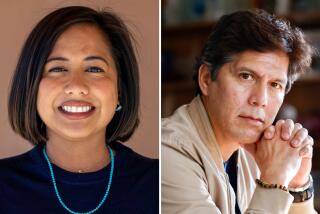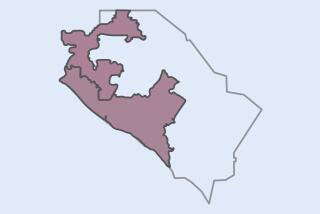A demographic snapshot of the new 9th and 13th City Council districts
- Share via
Tuesday’s election marks the first time voters in the newly drawn 9th and 13th City Council districts will cast their ballots. I thought it would be interesting to look at the demographics of the two.
In the 13th, which stretches from Hollywood to Silver Lake and Echo Park and down through Koreatown, 12 candidates are vying for a chance to represent a district that is 55% Latino, 22% non-Hispanic white, 18% Asian/Pacific Islander and 3% percent African American, according to Jared Sanchez of USC’s Center for the Study of Immigrant Integration. The data are based on the pooled annual numbers from the American Communities Survey.
The new district, like the old, is clearly one of the most diverse areas in the city. Just over half of the residents are immigrants. But it is also one of the most densely populated areas in the city. And though it includes more affluent neighborhoods, 22% of households in the district live below the poverty line and the median income is just under $38,000, according to the USC center.
In the 9th, seven candidates are fighting to lead a district that stretches from Washington Boulevard to East 9th and includes an offshoot that takes in Staples Center and L.A. Live. The new district no longer includes the economic corridor of downtown’s financial or fashion districts.
The demographic snapshot of the new 9th is bleak. The median household income is slightly over $29,000, and half of the children in the district live below the poverty line, while 37% of its households are living in poverty. Latinos account for 77% of the district’s residents and African Americans 16%, with the remaining 6% Asian or non-Hispanic white.
So how does this compare to the rest of the city? Both districts have significantly larger Latino populations and more immigrants. Just under 50% of the city’s residents are Latino, and 29% are non-Hispanic White, while 9% are African American. Asian and Pacific Islanders account for 11% of the city’s residents, according to the USC center. And both the 9th and 13th districts also have a larger share of individuals living in poverty.
While these statistics aren’t a big surprise, I think they are yet another reminder of what some of the big issues are going into Tuesday’s election.
ALSO:
When the government backs mortgages
Times endorsements: March 5 election
More to Read
A cure for the common opinion
Get thought-provoking perspectives with our weekly newsletter.
You may occasionally receive promotional content from the Los Angeles Times.









